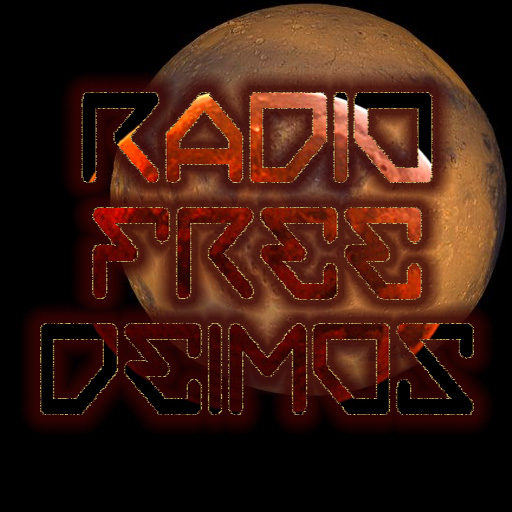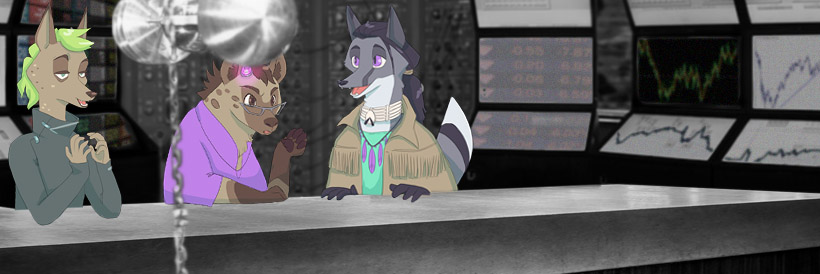This week’s episode is brought to you by sustained arguing forever. This week we talk about life in Pulse, and some of the folks you’ll meet there.
Episode #53 – Pulsetown!
Newest info from the world of HSD: the new Kickstarter expanding the minis line, and a relaunch of the same on the new HSD store on Shapeways! This one focuses mostly on signature NPCs and antagonists. There’s some really pretty stuff being thrown around on the HSD Discord channel, this expansion is looking really pretty!
Show Notes
♃ 1.53 – Other anthro mini sites, since we rambled through them: Dark Sword Miniatures “Visions in Fantasy Critters”, Burrows and Badgers, Song of the Splintered Lands. And proof that there at least WAS an Ironclaw miniatures line.
♃ 5.00 – Questions and Opinions, a throwback to last week where we forgot to mention the shadow president of Pulse, the White Queen. She’s an interesting one, a non-anthro fox who won her title but cares absolutely nothing for the corporation, or for vector society in general, except as an end to the means. She seems to be the main force steering vectors toward the strike on the Ruby Spire, which makes her one of the key forces in the game’s metaplot.
♃ 9.08 – On to the episode topic: Pulse Town, and the people therein.
♃ 9.20 – on arenas, the center of every Pulse community, or at least the hub. Pulse towns radiate outward from and inward to the arenas, one of the centers of Pulse life.
♃ 10.31 – Here’s the beginning of the article on Elysium, a non-canon seat of power for the Pulse empire and home of the nine linked city/arenas. It’s a stub right now, I’ll be adding to it over the course of the week.
♃ 11.45 another dropped reference to the 1948 Olympics and their nonstandard events, like poetry, statistics, and urban planning. You can make ANYTHING competitive if you try hard enough.
♃ 11.50 Pulse and competition: in many ways a Pulse corptown is one big scoreboard. Metrics for everyone’s performance are out there for the finding…school grades, presumably salaries, et cetera. If there’s a yardstick you can judge yourself and others by, it’s easy to find. Life becomes one big contest…YT compares it to Spyglass, which feels like almost the opposite. In Spyglass your SECRETS are open, but your life may not be quite as much an open book.
♃ 13.22 – a brief aside about popup businesses, flash sales, and forced scarcity. We talk a bit about the “Supreme” brand of hip hop merchandise, most of my very limited knowledge of which came from the Patriot Act show on Netflix. Hype and consumer frenzy used to drive up prices and a secondary market.
♃ 14.55 – how big is Pulse? We know that so far as the megacorps go, it’s one of the smallest, larger than TTI but TTI is more a megacorp by dint of the power of their product than their raw size. This likely means they have fewer spinoffs…they simply aren’t an empire. This is partly due to the intense and possibly insane mindset of a true Pulse employee. They’re also quite hands-off in their management..In #52 we talk briefly about the likelihood that Pulse has the fewest true employees, but the most contractors? This may be a way of managing large events so that there’s still surprise and chaos.
We talk a bit here about how to break up a Pulse town to accommodate the small citizenry and the hypercompetitive tribalism. A recurring theme, though we may not have said everything we wanted to say, the ideas were a bit subtexted…they tended to involve small pockets of Pulse lunacy influencing the neighbors.
One thing I thought of after the recording session and added later, the thought that Pulse might have an unusual corptown structure where they manage from on high but don’t have the feudal relationship of “citizen=employee=chattel.” There’s nothing to directly support this, but Pulse has a hands-off style that might make this arrangement, or something similar, more likely in a Pulse Town.
♃ 16.42 – on the community hub: Arenas, pubs. Pulse is bound by little community spots that bind people together. There was a connection to the World Cup Death Count that was either non-intuitive, or simply a non-sequitor.
♃ 18.31 – Pulse, kids, and perfection of the self. Ashtaar asks if Pulse creates more blips than other corporations. The hosts go back and forth on what competition and exploration means in this context. Parent competition, child pageants, kids as a vehicle for self-expression. Idiocracy and Natural Selection here:
♃ 24.20 – Endless Space 2 and the Horatio, a community of clones, and some parallel ideas from science fiction. I’m surprised we didn’t mention the Venture Bros and the endless cloning of Dr. Venture’s kids.
♃ 28.12 Ashtaar speculates on family life in Pulse, competition in the home.
♃ 30.44 Pulse and species extremism? Corbeau wonders if “be the best goat you can be” is a Pulse thing.
♃ 32.16 – the ongoing pulse social experiment. Stage hands and catalysts and random public mutations. Beacons and the League of Justice approach to community building.
♃ 38.24 – Pulse architecture. One big dangerous playscape.
♃ 44.50 – who are the people in your neighborhood? Scouts, Beacons, etc. Scouts at 45.04. One angle that would be a little different for scouts would be “Miracle in 34th Street” style, a loving push into the spotlight.
♃ 46.14 – A bit more on beacons and what they do.
♃ 46.42 – Kindling – the people that bump the mob forward, the button-pushers. The more subtle background forces pushing Pulse society around.
♃ 47.30 Catalysts and stagehands – the ones with the weird chemicals to twist society into weird shapes. Is this Pulse or TTI? Stagehands can turn anything into a combat zone. In a good way.
♃ 48.50 – “Mephistopheles” from Faust may be a good model for a Pulse catalyst type, tempting and baiting but more of a constant presence. By default they seem to move in and move on. Ashtaar seems to see them as a main actor type as much as support cast, but I feel like both Catalysts and Stagehands build the stage, set the stage, but don’t necessarily walk the stage. Ashtaar compares the role of Catalyst and Kindling to a mentor figure, more of a long-term change, not someone who dumps powder into the water supply and runs off. This discussion goes on for a while…
♃ 53.14 – Subsidiaries. Unfortunately there’s only four or five canon subsidiaries mentioned, mostly for MarsCo. YT speculates that there’s probably an oversight organizations for Scouts, Catalysts, etc. The year-end parties for Catalysts are fantastic. Don’t drink the spiked punch. Ashtaar suggests that most of the major sports leagues have their own major support structure. Later I bring up three home brew: Parallax, a travel-focused subsidiary; Mode, a youth culture/teen group; Titan Film Cooperative, a low-budget grindhouse. Really, I think every subsidiary I’ve sketched out has Pulse somewhere in it.
♃ 55.36 – the ongoing discussion on how big is Pulse’s media/marketing division..it seemed bigger in first edition, but over time MarsCo turned into the big media corp.
♃ 59.32 – YT asks about the intellectual side of Pulse. They DO represent non-martial arts, but in the same general way they handle sports…
♃ 1.01.03 – Working on a setting in the Elysium mountain range on Mars, three massive volcano caldera arenas with a basin packed with nine corptowns. More here. The reason I went down this road was to talk about competitive sports commentary, as a response to YT’s question.
♃ 1.04.01 – What’s new and fun this week? Neil Gaimen’s “Sandman” picked up by Netflix for a high-budget series, that’s exciting. I fell in like with the song “In the Martian Sunrise” by Nerd Rock Band Kraken Not Stirred, after hearing it on a recent episode of nerdcore podcast Radio Free Hipster. The album it’s from, “Songs from a Pale Blue Dot,” is a scifi concept album about space flight. YT mentions as a related article NASA’s return to the moon in 2024.
With thanks to Sirius Beat for our intro music, “Future Club,” and outro music, “Tronicles.” Our fun, modular header art is by Absyfield , (Thank you Ashley!) and Whines is our audio engineer.
Podcast: Play in new window | Download
Subscribe: RSS


Think that removal of the jock/nerd dichotomy brought chessboxing (yes, that’s a thing) into the mainstream?
I once ran a “beacons” campaign where Pulse contracted a supervillain catalyst to create enemies for the PCs to fight, his biggest feat was spiking the concessions at a sporting event where the PCs were competing.
That’s a pretty fun idea! Recruiting some one to play the villain and promising to clean up after to make sure they put on the best show, is pretty neat. I like the idea of a villain that’s actually being compensated by the government, that’s obvious. An when it’s all over, every one goes home with a fun story to share, and points on the score board.
Okay, I know I’m late on this but… POSITIVE change? I don’t think anything the Pulse shadow president does can be considered positive in any shape or form.
It is true, she’s not a very nice person. Or critter. I don’t know.
Pulse is pretty interesting to me, everything about them that you can look at, just explodes with question and possibilities. Both in shallow mechanical action, and in the sense of morality. The fact that so much can happen, but every one is pretty aware of that fact, really twists my sedentary life style mind. That any mundane task or job can be turned fantastical at any moment, but not that it needs to. It just, ‘could’.
I also think often about the individualism, and how important that is to pulse.
On the flip side, I think that a person can be self centered in the way of, being the best person at bringing out the best in others. The self improving through helping others was also a strong point I felt was relevant. With out needing to be mentioned in the text.
In order to be the best one needs to learn, and there will be lots of learned people to pursue.
Also something to note that while they are small, with Pulse being the main if not only provider for reclamation surgery and other enhancements of the like, they support all the other corps aside from maybe ASR. I bet they get allot of export to other corps, and since they can openly test things on their populous, it would not be as hard to develop things to be marketed, with plenty documentation to back it up.
With them having the largest media presence too, they would seem allot bigger over all, since they are just so much more visible.
I also liked the idea of that Titian subsidiary that specialized in the little league of sorts, to make sure any one can get some screen time.
I also like the concept of the social divisions getting melted together.